2. 中国科学院大学, 北京 100049;
3. 中国科学院 广州地球化学研究所, 同位素地球化学国家重点实验室, 广州 510640;
4. 桂林理工大学 地球科学学院, 广西 桂林 541006
2. University of Chinese Academy of Sciences, Beijing 100049, China;
3. State Key Laboratory of Isotope Geochemistry, Guangzhou Institute of Geochemistry, Chinese Academy of Sciences, Guangzhou 510640, China;
4. College of Earth Sciences, Guilin University of Technology, Guilin Guangxi 541006, China
大火成岩省是指以短时间(一般小于几个百万年)、巨量喷发(覆盖面积通常大于105 km2)为特征的富镁铁质喷出岩和侵入岩所构成的大规模岩浆岩建造(Coffin and Eldholm, 1994; Bryan and Ernst, 2008)。一般认为,如此短时的巨量基性岩浆喷发与“地幔柱”作用有关(Ernst and Buchan, 2003; Campbell,2005)。“地幔柱”假说(Wilson,1963; Morgan, 1971, 1972; White and McKenzie, 1989; Campbell and Griffiths, 1990; Griffiths and Campbell, 1990; Farnetani and Richards, 1994; Maruyama,1994; Zhao,2001;Montelli et al., 2004; Campbell,2005)认为,地球内部存在最终起源于地球核-幔边界的、缓慢上升的细长柱状热物质流,即地幔柱(mantle plume);热物质流上升过程中,经过地幔到达冷的岩石圈底部时,其顶部呈喇叭状张开,从而形成一个具有巨大球状顶冠和狭长尾柱的热幔柱构造;热幔柱巨大的球状顶冠与上覆板块相互作用,可引起岩石圈伸展减薄、地壳上隆和大规模溢流玄武岩火山作用,形成大陆或大洋溢流玄武岩省;而热幔柱狭长的尾柱与运动的上覆板块相互作用,则形成系列热点或火山链。
大火成岩省是国际地学界的研究热点,涉及地球内部运行机制和过程、成矿作用和生物环境效应等多个地学前沿研究领域(Wignall,2001; 徐义刚,2002; Morgan et al., 2004; 徐义刚等,2013a; Xu et al., 2014)。中国西南滇-川-黔地区,即扬子克拉通的西缘,地表出露大面积二叠纪玄武岩(如图 1a所示),地质上命名为峨眉山大火成岩省(Emeishan Large Igneous Province,简称ELIP)。它不仅是中国境内第一个获得国际学术界广泛认可的大火成岩省(徐义刚等,2013b),也是全球范围内研究程度最高的大陆溢流玄武岩省之一(Bryan and Ferrari, 2013)。其喷发时间为二叠-三叠纪之交(Chung and Jahn, 1995; Zhong et al., 2014),与地球历史中最大规模的海平面下降、地球磁场Illawarra反转等全球变化事件,以及双生物灭绝等生物灾变事件存在时间上的耦合关系(Haag and Heller, 1991; Erwin,1993; Stanley and Yang, 1994; Wignall and Twitchett, 1996; Knoll et al., 1996; Wang and Sugiyama, 2000; Zhou et al., 2002; Foster and Afonin, 2005; Isozaki et al., 2007; Heydari et al., 2008; Wignall et al., 2009)。峨眉山玄武岩的下伏岩层-晚中二叠纪茅口组灰岩,在中国华南地区广泛发育,且保存相对完整(He et al., 2003; Xu et al., 2004; Ali et al., 2005; Isozaki et al., 2007);区内矿产资源丰富,赋存攀枝花钒钛磁铁矿床、铜镍硫化物矿床等世界级大型矿床(Wang et al., 2005; Zhou et al., 2008; 郑文勤等,2014),为开展古生物地层学、沉积地层学、岩石地球化学、矿床地球化学等多学科研究提供了绝佳条件,因而成为开展大火成岩省相关研究的理想地区。

|
(a)二叠纪峨眉山玄武岩分布;(b)“地幔柱头熔融”模型;修改自Xu等(2004) 图 1 峨眉山大火成岩省分区特征与“地幔柱头熔融”成因模型 Figure 1 The distribution of the Emeishan Permian basalts(a) and the model of "melting of the mantle plume head" for the formation of Emeishan Large Igneous Province(ELIP)(b) |
前人根据沉积地层学揭示的下伏茅口灰岩的剥蚀程度、熔岩的Ti含量等岩石地球化学特征等将峨眉山大火成岩省分为内带、中带和外带(如图 1a所示),并提出了内带下方“地幔柱头熔融”成因模型(如图 1b所示)(Chung and Jahn, 1995; Xu et al., 2001, 2004;He et al., 2003),但深部是否存在“地幔柱头熔融”模式所预示的地幔柱作用“遗迹”,包括岩浆作用的具体位置和规模、组分特征与来源、深浅响应过程等,均有待深部地球物理探测结果的约束或检验(Coffin and Eldholm, 1994; Xu et al., 2007; Xu and He, 2007; 徐义刚等,2007)。
1 科学思路深部地球物理,尤其是地震学,是探测现代地幔柱的有效手段。夏威夷、冰岛、黄石等现代热点的地震层析成像研究结果(Wolfe et al., 1997; Shen et al., 1998; Nataf,2000; Zhao,2001; Christiansen et al., 2002; Montelli et al., 2004; Lei and Zhao, 2006),曾几度成为检验地幔柱学说的“试金石”,在地幔柱学说的建立和大讨论过程中发挥了不可替代的重要作用(Morgan,1971; Anderson,2003)。地震学探测现代地幔柱所依赖的基本线索是地幔柱活动伴随的热效应所引起的显著的地震波低速异常(French and Romanowicz, 2015; Hand,2015)。然而,经过漫长的地质历史时期,大火成岩省一般都经历了大尺度时-空旅行。以峨眉山大火成岩为例,它的主喷发期约为259 Ma(Zhong et al., 2014),那时其所处的扬子板块尚位于赤道以南的低纬度地区,而现今却位于北纬30°附近(Bryan et al., 2002; Ali et al., 2005)。也就是说,峨眉山大火成岩省自喷发至今,至少经历了2.5亿年,向北漂移了3000多千米(如图 2所示)。一般认为,板块是漂移的,而地幔柱是相对固定的(Torsvik et al., 2014)。大火成岩省现今所处的位置与地幔柱之间的空间位置不再对应,以及与地幔柱作用有关的热结构丧失是造成地球物理探测古老地幔柱困难的根本原因。也正因为如此,对古老地幔柱的识别,主要依靠岩石地球化学、沉积地层学、古生物地层学等学科手段,较少涉及系统的深部地球物理探测(Xu et al., 2004; 徐义刚等,2013b)。
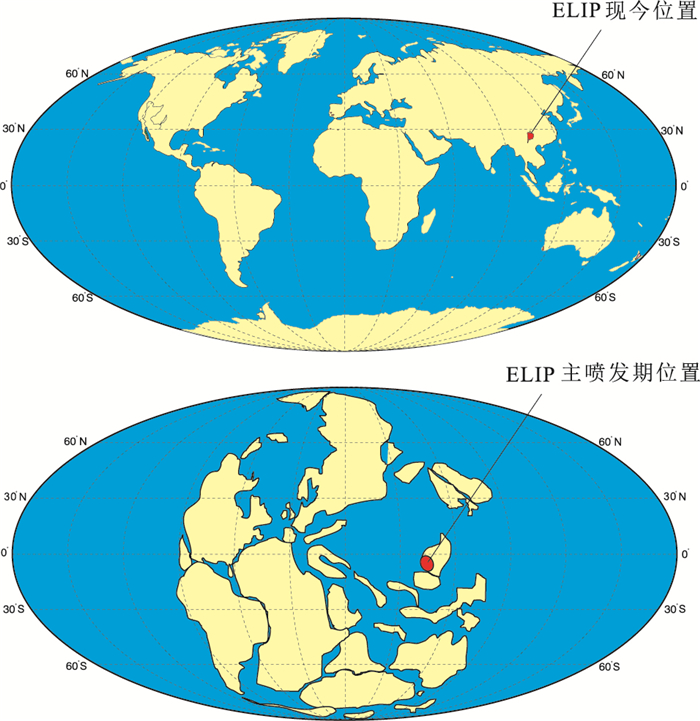
|
ELIP为峨眉山大火成岩省;图件修改自Bryan等(2002),Ali等(2005) 图 2 峨眉山大火成岩省经历的空间位置变化示意图 Figure 2 The present location of ELIP and its emplacement site shown in a paleogeographic map of late Permian(~259 Ma) |
大火成岩省作为地球上目前已知的最大规模火山作用,不仅会在地表直观地留下岩浆喷出的产物-大面积溢流玄武岩,而且在地球固化本体内部,也会保留大规模岩浆侵入的“遗迹”-来自地球深部的、大规模炽热岩浆,在穿透上覆板块过程中,势必会引起岩石圈地幔和地壳的组分改造和结构变化(Sun,1989; Rudnick,1990; Cox,1993; Xu and He, 2007; Thybo and Artemieva, 2013)(如图 3所示),而显著的组分改造和结构变化则可能是深部地球物理探测可以追踪到的重要线索。

|
板块漂移造成大火成岩省远离地幔柱所在位置,热结构随时间逐渐丧失,但固化本体内部却可能保留大规模岩浆侵入的“遗迹” 图 3 古地幔柱作用与壳幔结构响应示意图 Figure 3 Schematic illustration of the compositional and structural records related to the ancient plume activities remained in the crust and lithospheric mantle. Note that, the drifting away from the original site and the thermal decay would result in great difficulty in tracing an ancient plume for geophysical investigation |
因此,以大火成岩省固化本体中保留的、大规模岩浆作用所引起的组分和结构特征响应为突破口,利用综合地球物理重建地壳和岩石圈地幔精细结构为技术手段,通过几何结构、物性结构和动力学属性特征等提供的多尺度、多参数联合约束,可达到鉴别细节的真伪、区分古今地质效应之目的,从而最终实现古地幔柱作用“遗迹”的探测和鉴别,为大火成岩省的成因及深部过程研究提供可靠的地球物理学证据。
2 峨眉山大火成岩省地球物理探测的主要进展2010年11月至2013年4月,在科技部973计划项目的支持下,中国科学院地质与地球物理研究所在峨眉山大火成岩省组织实施了人工地震测深、宽频带地震台阵探测、密集重力/地磁剖面测量等系列综合地球物理探测(图 4)。剖面西起滇西福贡,东至贵州贵定,横跨西南三江地区和峨眉山大火成岩省内带-中带-外带,全长约900 km。该系列深部地球物理探测,是首次具体针对峨眉山大火成岩省形成机制而组织实施的综合地球物理剖面探测,为该区壳幔精细结构与深部过程研究提供了宝贵的、丰富的数据基础。
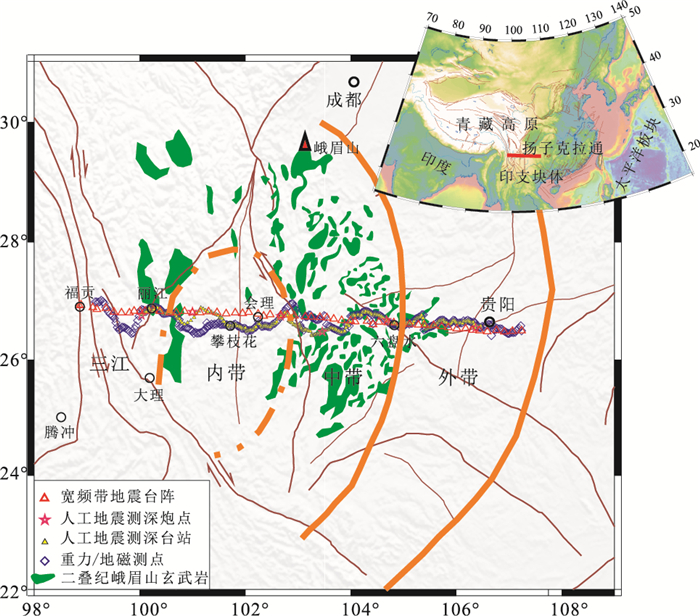
|
右上角子图所示为剖面所处大地构造位置 图 4 峨眉山大火成岩省深部地球物理探测剖面位置图 Figure 4 Shaded topographic map showing regional geologic features in ELIP and the location of comprehensive geophysical investigation |
基于获得的综合地球物理数据,开展了岩石圈精细结构重建和动力学属性分析工作,比较系统地建立了古地幔柱作用“遗迹”鉴别的系列地球物理标志(图 5)。主要包括:① 与古地幔柱岩浆作用有关的深部过程在固化地球本体中所保留的壳幔结构特征响应。内带以“地壳增厚”和“岩石圈减薄”为主要特征,在地壳下部残存“底侵”(underplating)界面、上地壳底界面(也称康拉德不连续面,Conrad discontinuity)因“内侵”(intraplating)作用而消失,造成上地壳“透明化”(Chen et al., 2015; 徐涛等,2015; Deng et al., 2016; 徐义刚等,2017)。② 与古地幔柱岩浆作用有关的深部过程在固化地球本体中所保留的物性特征响应。内带地壳以高Vp,高Vs,高Vp/Vs,高密度、低大地热流为主要特征;同时,岩石圈地幔也相对高速,明显区别于现今热效应减薄对应的“薄岩石圈、低波速、高热流”等特征(Deng et al., 2014; Chen et al., 2015; 徐涛等,2015; Deng et al., 2016; 郭希等,2017;徐义刚等,2017)。③ 与古地幔柱岩浆作用有关的深部过程在固化地球本体中所保留的动力学属性特征响应。内带地壳以径向各向异性强、方位各向异性深浅耦合、强度大(地震发震层厚度大)为主要特征(Wu and Zhang, 2012;Chen et al., 2013)。
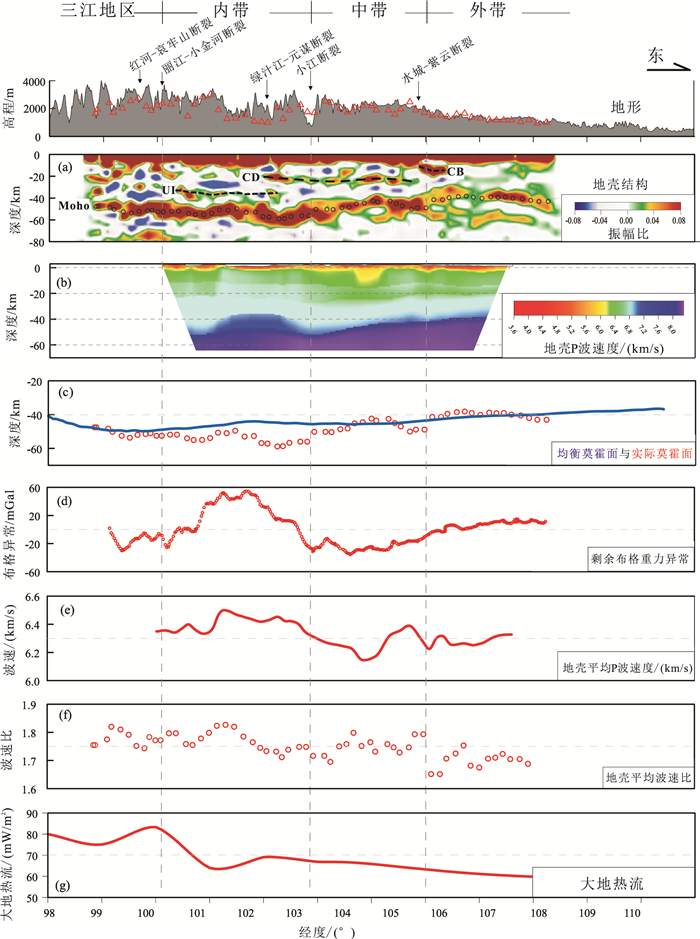
|
(a)为接收函数偏移成像得到的地壳几何结构,UI为底侵顶界面,CD为康拉德不连续面,CB为结晶基底顶界面;(b)为人工地震测深得到的地壳P波速度结构;(c)为根据现今地形估算得到均衡莫霍面与接收函数偏移成像得到的实际莫霍面之间的比较;(d)为剩余布格重力异常;(e)为地壳平均P波速度;(f)为地壳平均纵横波速度比;(g)为沿剖面大地热流分布。内带地壳特征显著,物性方面表现出高波速、高密度、高波速比、低热流等特征; 几何结构方面表现出地壳厚度大、下地壳多出一个“夹层”、上地壳底界面缺失等特征 图 5 峨眉山大火成岩省的地球物理响应特征 Figure 5 Multidisciplinary geophysical observations along the profile |
通过此项综合地球物理探测,丰富了峨眉山大火成岩省的科学研究内涵,对其他古地幔柱作用“遗迹”研究,提供了较好的案例和借鉴意义。
2.2 大规模岩浆作用的深浅响应过程地表出露的大面积玄武岩是大规模岩浆作用最直观的表达,而地壳内部岩浆“底侵”和“内侵”则是岩浆喷发之前必经的物理-化学过程(Sun,1989; Rudnick,1990; Campbell and Griffiths, 1990; Fyfe,1992; Cox,1993; Coffin and Eldholm, 1994; Chung and Jahn, 1995; Xu and He, 2007)。确定“底侵”的具体位置和规模是探测和鉴别古地幔柱作用的关键。借助以上地球物理响应特征,即内带地壳增厚、上地壳底界面缺失、下地壳内部出现夹层,且“夹层”具有显著的“三高一低”特征(高密度、高波速、高波速比、低热流),不仅可以可靠地确定岩浆“底侵”的具体位置、规模,而且可以对岩浆组分特征、来源深度,以及深浅作用过程等提供系统制约。
以峨眉山大火成岩省为例,二维剖面成像结果显示,“底侵”位于内带的下方,层厚15~20 km(顶界面深度约35 km,底界面深度约50~55 km),横向尺度约150~180 km(图 5)。
2.2.1 岩浆组分特征约束高密度、高波速、高波速比和较低的大地热流值(图 5d~5g),可以联合约束并可靠指示其组分特征以镁铁质/超镁铁质为主。高波速比(可等效换算为泊松比),一般可由组分效应(镁铁质/超镁铁质组分为主)、物理状态(部分熔融)、热效应(高温)等因素引起(Christensen,1996)。定性地判断,熔融和高温一般会对应较低的地震波速和较高的大地热流,而人工地震测深获得的速度结构剖面显示,该区不仅不存在任何显著的低波速异常,而且在下地壳底部存在高速异常区(图 5b);该区的大地热流数据显示,“底侵”上方的大地热流值相对东西两侧较低(图 5g)。这种相对较低的大地热流值,不仅可以排除高波速比不是由于高温或部分熔融引起,而且与幔源物质极低的生热率存在很好的对应关系(Furlong and Chapman, 2013),从而可以定性地判断内带的高波速比特征确由镁铁质/超镁铁质组分引起。
上述组分约束,也可以通过不同区带地壳厚度-波速比变化关系(如图 6所示)之间的对比得到进一步验证。一般大陆地壳平均厚度约为39 km(Christensen and Mooney, 1995),平均波速比约为1.75(Christensen,1996)。研究区地壳厚度较大,内带最厚(约54 km),其次为三江地区(约50 km);且内带和三江地区的地壳波速比均值均高于1.75(内带为1.77,三江地区为1.78),意味着高波速比物质(组分上偏基性或/和状态上存在熔融)在地壳增厚过程中起到了重要作用。尽管三江地区和内带地壳厚度、波速比的均值均较大,但地壳厚度-波速比变化关系却截然不同。三江地区地壳厚度-波速比之间存在正相关(斜率为正),即地壳厚度随波速比增大而增大,不仅意味着三江地区的地壳增厚与高波速比物质的添加有关,而且这种添加可能仍在进行之中;而内带地壳厚度-波速比之间存在负相关(斜率为负),意味着目前显示的高波速比特征来自本底的继承,即高波速比物质添加所引起的地壳增厚在地质历史时期已经完成,后期的地壳增厚与高波速比物质的添加无关。上述特征可以通过二叠纪地幔柱在内带的短期大规模幔源(基性/超基性)岩浆作用,以及新生代以来印度-亚洲大陆碰撞所引起的青藏高原东南缘的地壳增厚(Royden et al., 1997)或印度板块东向俯冲引起的深部物质上涌(Lei et al., 2009; Lei and Zhao, 2016)等深部过程得到合理解释。
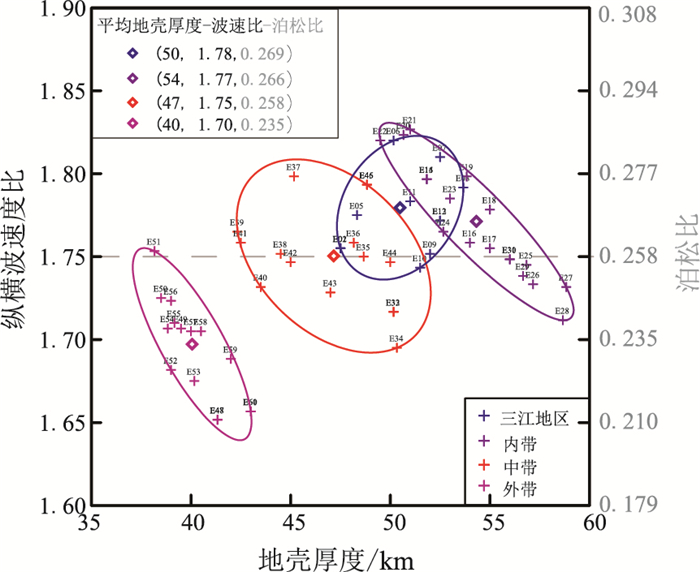
|
图 6 峨眉山大火成岩省不同区带地壳厚度与波速比(泊松比)变化关系对比图 Figure 6 Crustal thickness vs. Vp/Vs ratios(Poisson's ratios) of different zones along the profile. |
来自实验岩石学和数值模拟的研究结果表明,底侵层厚度与侵位深度、母岩浆的原始温度或来源深度有关(Furlong and Fountain, 1986; 王振华等,2017)。底侵层厚15~20 km,在30~40 km深度侵位,意味着原始岩浆具有很高的潜温(约1600℃)(Furlong and Fountain, 1986)和大体量初始岩浆侵入(初始岩浆侵入厚度达30~40 km)(王振华,2017)。且15~20 km厚度是保守的估计,没有考虑到隐伏的岩墙和喷出的体量,因此原始岩浆的潜温只能更高,从而排除了“底侵”的岩浆来自岩石圈内部熔融的可能,只能来自地球更深部(Chen et al., 2015)。这一定性约束,与已有的系列岩石地球化学研究成果之间存在较好的一致性(徐义刚和钟孙霖,2001;Zhang et al., 2006)。
2.2.3 岩浆作用的深浅响应过程在进一步估算底侵层密度的基础上(Deng et al., 2016),考虑到岩石圈的重力均衡效应,15~20 km厚的底侵物质添加(密度约3.14 g/cm3),可引起地表 1.0~1.5 km的隆升(Chen et al., 2015)。在“底侵”位置正上方鲜有二叠纪玄武岩保留,而在远离“底侵”位置的中带却有大面积分布(图 7a),这种空间位置上的“互补”,应该绝非巧合,暗示该“底侵”事件与中带大面积出露的二叠纪玄武岩之间存在着某种成因联系。至此,峨眉山大火成岩省的深浅过程(图 7b)可概括为:来自地球深部的大规模岩浆,在地壳底部堆积,形成“底侵”;岩浆分异、继续上行过程中,破坏了上地壳底界面(康拉德界面),造成了上地壳的“透明化”;地表隆升,岩浆喷出,向四周溢流,形成大陆溢流大火成岩省。内带高隆起部位,随着后期的长期风化、剥蚀,喷出的玄武岩较少得到保留,而地形较低的中带和外带因风化剥蚀程度较低而得到保留,从而呈现“底侵”位置与现存溢流玄武岩分布在空间位置上的“互补”关系。东侧小江断裂的正断(He et al., 2003)和水城-紫云裂陷槽的裂陷(王尚彦等,2006)等区域典型构造事件,也可以统一到大规模岩浆作用所导致的地壳大幅度垂向生长这一动力体系之中(Chen et al., 2015)。
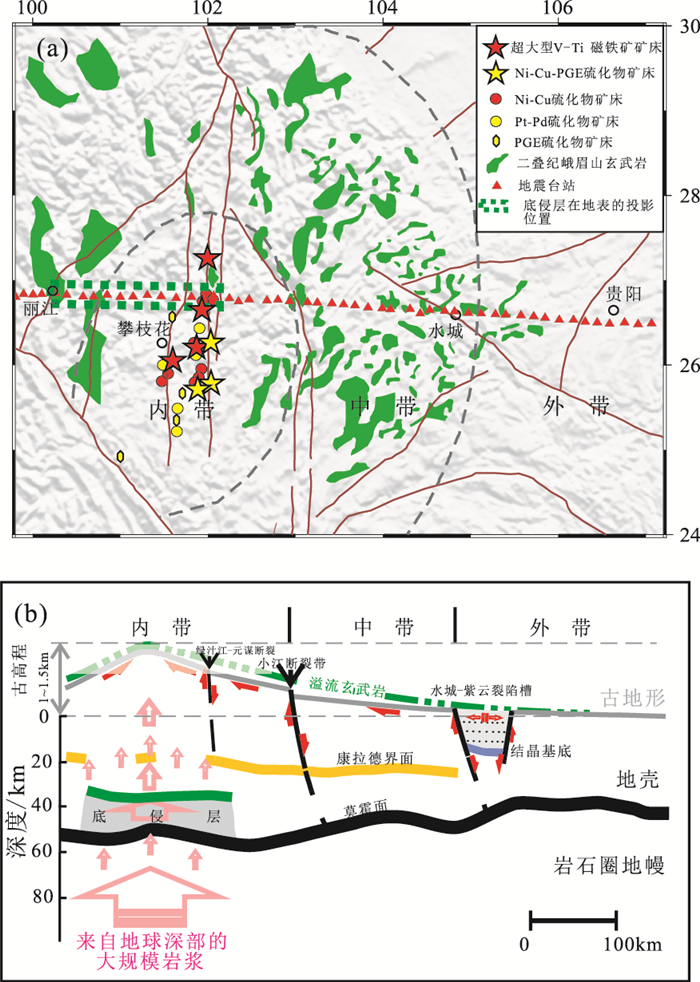
|
(a)内带主要矿床分布及二维地震剖面揭示的“底侵”在地表的投影位置;(b)大规模岩浆作用的深浅响应过程。其中,地壳几何结构由接收函数偏移成像结果图 5a按比例尺提取得到;主要矿床分布参考Wang等(2005);郑文勤等(2014) 图 7 峨眉山大火成岩省主要矿床分布、大规模岩浆作用“底侵”位置及其深浅响应过程 Figure 7 The distribution of large deposits and the interpretative cartoon that summarizes the observation of the crustal structures and dynamic responses in ELIP |
峨眉山大火成岩省内带所在区域是中国重要的金属和稀有金属矿产资源可持续开发基地。区内赋存攀枝花等多个世界级超大型V-Ti磁铁矿矿床和Ni-Cu-PGE、Ni-Cu、Pt-Pd、PGE等众多硫化物矿床(图 7a)。以V-Ti磁铁矿为例,总储量超过100×108 t,其中,V和Ti的储量分别占世界储量的11.6%和35.17%,占中国总储量的62.6%和90.54%(郑文勤等,2014)。
内带现已发现的超大型V-Ti磁铁矿矿床和众多硫化物矿床,自西向东主要沿攀枝花断裂、绿汁江-元谋断裂和安宁河断裂等南北走向深大断裂分布(图 7a),意味着这些深大断裂为成矿岩浆提供了重要的上涌和溢流通道。在二维剖面上,本项研究揭示的“底侵”层位于丽江-攀枝花段(横向尺度长达150~180 km)(图 5a,图 7a)。通过位置对比,不难发现,与上述主要矿床赋存有关的深大断裂位于“底侵”层上方东侧区域(图 7),矿床分布区域在横向上所占比例尚不足整个“底侵”层横向尺度的1/3。“底侵”层正上方和上方西侧区域有无找矿潜力,非常值得探讨。在深部找矿方向上,一方面,地质上需要非常重视“底侵”层上方和周边断裂的详细调查;另一方面,从地球物理探测的角度,除了需要圈定“底侵”层的三维空间展布外,还需要特别重视“底侵”层上方上地壳“透明化”细节的探查,即利用短周期密集地震台阵探测或近垂直深反射地震探测等高精度地震探测技术,详细调查大陆地壳普遍存在的“康拉德不连续面”在内带发生缺失的具体细节,将探测获得的“康拉德不连续面”缺失的细节特征与结晶基底的地形特征相结合,则可能进一步有效揭示和确定尚未发现或隐伏的岩浆通道,从而为该区的深部找矿提供技术支撑与方向指导。
3 结语地球的外层固化层圈——岩石圈(包括地壳和岩石圈地幔),是记录地球演化历史的天然“档案馆”。尤其是地壳,尽管其在整个地球体积占比中显得微乎其微,但其记录地球演化信息的能力却超乎其他任何圈层(Hawkesworth et al., 2013)。在地球漫长的演化历史中,不同地质历史时期发生的每一次重大地质事件,都会以组分和结构改造的方式,或多或少地在地壳中留下自己的“印记”。过去和现今各种地质作用及其效应的长期复合叠加,决定了地壳所蕴含信息的丰富性和复杂性。地球物理成像所获得的,是现今以及地球不同历史时期各种地质作用及其效应长期叠加的“映像”。暂且不论地球物理观测数据不完备导致的多解性以及反演或成像算法自身的误差和精度,由于地球物理方法本身一般无法提供地质时间约束,要从这些“映像”中,区分过去和现今重大地质事件的作用和效应,终归显得困难重重。利用地球物理探测和鉴别古老的地幔柱作用及效应更是如此。在厘清研究对象的时-空位置变化,有机结合地质、地球化学等多学科研究成果的基础上,开展有针对性的综合地球物理调查显得尤其重要。
(1) 古地幔柱作用的实质是大规模岩浆活动,利用地球物理方法探测古地幔柱作用“遗迹”,岩浆“底侵”位置和规模的确定至关重要。“底侵”位置和规模的确定,为探讨组分特征、来源深度,以及深浅响应过程提供了基本前提。为了可靠地确定“底侵”的位置和规模,不同于现今的地幔柱或热点探测,单一的地震学方法很难奏效,需重视集成利用包括重、磁、电、震、地热等综合地球物理探测手段和多参数数据“去伪存真”,将单一方法的不确定性系统地约束至最小,才可能为后续深入研究提供可靠的前提和基础。
(2) 由于地球物理方法一般不具备时间约束的特性,需超越地球物理方法本身,在厘清地质历史时期研究对象时-空变化过程的基础上,与地质、地球化学等多学科资料有机结合,通过不同区带结构和物性特征的有效提取和对比,实现“将今论古”,从而最终“鉴别古今”。否则,即便发现和确定了“底侵”的位置和规模,也无法区分是现今正发生的地质作用效应,还是过去古老地质事件的“遗迹”,更无法确定与过去哪个时期、哪次重大地质事件相联系。典型区段对比、多学科集成是解决这一问题的关键。比如,通过将地球物理确定的“底侵”的位置和具有可靠年代学约束的典型岩性露头之间的空间位置关系对比,剖面上目标区段和已知的典型地质作用区段之间的结构和物性特征对比,地球物理发现的深部结构/构造与地质学揭示的典型构造事件的关联,以及基于已探明的“底侵”位置和规模约束下的热力学数值模拟(蒙伟娟等,2015;王振华等,2017),等等。
(3) 利用地球物理探测鉴别古老重大地质事件作用“遗迹”,乃至重建其深浅响应过程,依然任重而道远。在一些过去和现今地质作用强烈叠加的区域,尤其是一些年代既不是特别新,但也不是特别老的大火成岩省(如印度德干大火成岩省,喷发年龄为~65 Ma),在地幔柱作用的热效应究竟能够维持多久尚存争议的情况下(McKenzie,1984; Campbell,2005; 朱传庆等,2010; 何丽娟,2011),个别地球物理响应特征与地幔柱作用之间的关联愈发显得困难(Kennett and Widiyantoro, 1999; Deshpande and Mohan, 2016)。解决这一问题的出路,一方面,需要厘清地质时-空变化过程,通过地质、地球化学、地球物理等多学科的集成研究来解决;另一方面,需要有针对性的、系统的综合地球物理探测提供的多参数、多尺度有效约束。
致谢: 衷心感谢特约编辑的约稿,以及两位评审专家对此文提出的宝贵的修改意见和建议,对他们为此付出的辛苦劳动表示崇高敬意。
| [] | Ali J R, Thompson G M, Zhou M F, Song X Y. 2005. Emeishan large igneous province, SW China. Lithos, 79(3-4): 475–489. DOI:10.1016/j.lithos.2004.09.013 |
| [] | Anderson D L. 2003. Look again. Astronomy & Geophysics, 44(1): 10–11. |
| [] | Bryan S, Ernst R E. 2008. Revised definition of large igneous provinces(LIPs). Earth-Science Reviews, 86(1-4): 175–202. DOI:10.1016/j.earscirev.2007.08.008 |
| [] | Bryan S E, Ferrari L. 2013. Large igneous provinces and silicic large igneous provinces: Progress in our understanding over the last 25 years. Geological Society of America Bulletin, 125(7-8): 1053–1078. DOI:10.1130/B30820.1 |
| [] | Bryan S E, Riley T R, Jerram D A, Stephens C J, Leat P T. 2002. Silicic volcanism: An undervalued component of large igneous provinces and volcanic rifted margins. In: Klemperer S L, Ebinger C J, Baker J(eds). Volcanic Rifted Margins: Boulder, Colorado, Geological Society of America Special Paper, 362: 99-120 |
| [] | Campbell I H, Griffiths R W. 1990. Implications of mantle plume structure for the evolution of flood basalts. Earth and Planetary Science Letters, 99(1-2): 79–93. DOI:10.1016/0012-821X(90)90072-6 |
| [] | Campbell I H. 2005. Large igneous provinces and the mantle plume hypothesis. Elements, 1(5): 265–269. DOI:10.2113/gselements.1.5.265 |
| [] | Chen Y, Zhang Z J, Sun C Q, Badal J. 2013. Crustal anisotropy from Moho converted Ps wave splitting analysis and geodynamic implications beneath the eastern margin of Tibet and surrounding regions. Gondwana Research, 24(3-4): 946–957. DOI:10.1016/j.gr.2012.04.003 |
| [] | Chen Y, Xu Y G, Xu T, Si S K, Liang X F, Tian X B, Deng Y F, Chen L, Wang P, Xu Y H, Lan H Q, Xiao F H, Li W, Zhang X, Yuan X H, Badal J, Teng J W. 2015. Magmatic underplating and crustal growth in the Emeishan Large Igneous Province, SW China, revealed by a passive seismic experiment. Earth and Planetary Science Letters, 432: 103–114. DOI:10.1016/j.epsl.2015.09.048 |
| [] | Christensen N I, Mooney W D. 1995. Seismic velocity structure and composition of the continental crust: A global view. Journal of Geophysical Research, 100(B6): 9761–9788. DOI:10.1029/95JB00259 |
| [] | Christensen N I. 1996. Poisson's ratio and crustal seismology. Journal of Geophysical Research, 101(B2): 3139–3156. DOI:10.1029/95JB03446 |
| [] | Christiansen R L, Foulger G, Evans J R. 2002. Permian-mantle origin of the Yellowstone hotspot. Geological Society of America Bulletin, 114(10): 1245–1256. DOI:10.1130/0016-7606(2002)114<1245:UMOOTY>2.0.CO;2 |
| [] | Chung S L, Jahn B M. 1995. Plume-lithosphere interaction in generation of the Emeishan flood basalts at the Permian-Triassic boundary. Geology, 23(10): 889–892. DOI:10.1130/0091-7613(1995)023<0889:PLIIGO>2.3.CO;2 |
| [] | Coffin M F, Eldholm O. 1994. Large igneous provinces: Crustal structure, dimensions, and external consequences. Reviews of Geophysics, 32(1): 1–36. DOI:10.1029/93RG02508 |
| [] | Cox K G. 1993. Continental magmatic underplating. Philosophical Transactions of the Royal Society A: Mathematical, Physical and Engineering Sciences, 342(1663): 155–166. DOI:10.1098/rsta.1993.0011 |
| [] | Deng Y F, Zhang Z J, Mooney W, Badal J, Fan W M, Zhong Q. 2014. Mantle origin of the Emeishan large igneous province(South China)from the analysis of residual gravity anomalies. Lithos, 204: 4–13. DOI:10.1016/j.lithos.2014.02.008 |
| [] | Deng Y F, Chen Y, Wang P, Essa K S, Xu T, Liang X F, Badal J. 2016. Magmatic underplating beneath the Emeishan large igneous province(South China)revealed by the COMGRA-ELIP experiment. Tectonophysics, 672-673: 16–23. DOI:10.1016/j.tecto.2016.01.039 |
| [] | Deshpande A A, Mohan G. 2016. Seismic evidence for crustal heterogeneity beneath the northwestern Deccan volcanic province of India from joint inversion of Rayleigh wave dispersion measurements and P receiver functions. Journal of Asian Earth Sciences, 128: 54–63. DOI:10.1016/j.jseaes.2016.07.022 |
| [] | Ernst R E, Buchan K L. 2003. Recognizing mantle plumes in the geological record. Annual Review of Earth and Planetary Sciences, 31(1): 469–523. DOI:10.1146/annurev.earth.31.100901.145500 |
| [] | Erwin D H. 1993. The Great Paleozoic Crisis: Life and Death in the Permian.New York: Columbia University Press: 327. |
| [] | Farnetani C G, Richards M A. 1994. Numerical investigations of the mantle plume initiation model for flood basalt events. Journal of Geophysical Research, 99(B7): 13813–13833. DOI:10.1029/94JB00649 |
| [] | Foster C B, Afonin S A. 2005. Abnormal pollen grains: An outcome of deteriorating atmospheric conditions around the Permian-Triassic boundary. Journal of the Geological Society, 162(4): 653–659. DOI:10.1144/0016-764904-047 |
| [] | French S W, Romanowicz B. 2015. Broad plumes rooted at the base of the Earth's mantle beneath major hotspots. Nature, 525(7567): 95–99. DOI:10.1038/nature14876 |
| [] | Furlong K P, Fountain D M. 1986. Continental crustal underplating: Thermal considerations and seismic-petrologic consequences. Journal of Geophysical Research, 91(B8): 8285–8294. DOI:10.1029/JB091iB08p08285 |
| [] | Furlong K P, Chapman D S. 2013. Heat flow, heat generation, and the thermal state of the lithosphere. Annual Review of Earth and Planetary Sciences, 41(1): 385–410. DOI:10.1146/annurev.earth.031208.100051 |
| [] | Fyfe W S. 1992. Magma underplating of continental crust. Journal of Volcanology and Geothermal Research, 50(1-2): 33–40. DOI:10.1016/0377-0273(92)90035-C |
| [] | Griffiths RW, Campbell IH. 1990. Stirring and structure in mantle starting plumes. Earth and Planetary Science Letters, 99(1-2): 66–78. DOI:10.1016/0012-821X(90)90071-5 |
| [] | Haag M, Heller F. 1991. Late Permian to early Triassic magnetostratigraphy. Earth and Planetary Science Letters, 107(1): 42–54. DOI:10.1016/0012-821X(91)90042-G |
| [] | Hand E. 2015. Mantle plumes seen rising from Earth's core. Science, 349(6252): 1032–1033. DOI:10.1126/science.349.6252.1032 |
| [] | Hawkesworth C, Cawood P, Dhuime B. 2013. Continental growth and the crustal record. Tectonophysics, 609: 651–660. DOI:10.1016/j.tecto.2013.08.013 |
| [] | He B, Xu Y G, Chung S L, Xiao L, Wang Y M. 2003. Sedimentary evidence for a rapid, kilometer-scale crustal doming prior to the eruption of the Emeishan flood basalts. Earth and Planetary Science Letters, 213(3-4): 391–405. DOI:10.1016/S0012-821X(03)00323-6 |
| [] | Heydari E, Arzani N, Hassanzadeh J. 2008. Mantle plume: The invisible serial killer-Application to the Permian-Triassic boundary mass extinction. Palaeogeography, Palaeoclimatology, Palaeoecology, 264(1-2): 147–162. DOI:10.1016/j.palaeo.2008.04.013 |
| [] | Isozaki Y, Shimizu N, Yao J X, Ji Z S, Matsuda T. 2007. End-Permian extinction and volcanism-induced environmental stress: The Permian-Triassic boundary interval of lower-slope facies at Chaotian, South China. Palaeogeography, Palaeoclimatology, Palaeoecology, 252(1-2): 218–238. DOI:10.1016/j.palaeo.2006.11.051 |
| [] | Kennett B L N, Widiyantoro S. 1999. A low seismic wavespeed anomaly beneath northwestern India: A seismic signature of the Deccan plume?. Earth and Planetary Science Letters, 165(1): 145–155. DOI:10.1016/S0012-821X(98)00260-X |
| [] | Knoll A H, Bambach R K, Canfield D E, Grotzinger J P. 1996. Comparative earth history and Late Permian mass extinction. Science, 273(5274): 452–457. DOI:10.1126/science.273.5274.452 |
| [] | Lei J S, Zhao D P. 2006. A new insight into the Hawaiian plume. Earth and Planetary Science Letters, 241(3-4): 438–453. DOI:10.1016/j.epsl.2005.11.038 |
| [] | Lei J S, Zhao D P, Su Y J. 2009. Insight into the origin of the Tengchong intraplate volcano and seismotectonics in southwest China from local and teleseismic data. Journal of Geophysical Research, 114(B5): B05302. DOI:10.1029/2008JB005881 |
| [] | Lei J S, Zhao D P. 2016. Teleseismic P-wave tomography and mantle dynamics beneath Eastern Tibet. Geochemistry Geophysics Geosystems, 17(5): 1861–1884. DOI:10.1002/2016GC006262 |
| [] | Maruyama S. 1994. Plume tectonics. The Journal of the Geological Society of Japan, 100(1): 24–49. DOI:10.5575/geosoc.100.24 |
| [] | McKenzie D. 1984. A possible mechanism for epeirogenic uplift. Nature, 307(5952): 616–618. DOI:10.1038/307616a0 |
| [] | Montelli R, Nolet G, Dahlen F A, Masters G, Engdahl ER, Hung SH. 2004. Finite frequency tomography reveals a variety of plumes in the mantle. Science, 303(5656): 338–343. DOI:10.1126/science.1092485 |
| [] | Morgan J P, Reston T J, Ranero C R. 2004. Contemporaneous mass extinctions, continental flood basalts, and'impact signals': Are mantle plume-induced lithospheric gas explosions the causal link?. Earth and Planetary Science Letters, 217: 263–284. DOI:10.1016/S0012-821X(03)00602-2 |
| [] | Morgan W J. 1971. Convection plumes in the lower mantle. Nature, 230(5288): 42–43. DOI:10.1038/230042a0 |
| [] | Morgan W J. 1972. Plate motions and deep mantle convection. GSA Memoirs, 132: 7–22. |
| [] | Nataf HC. 2000. Seismic imaging of mantle plumes. Annual Review of Earth and Planetary Sciences, 28(1): 391–417. DOI:10.1146/annurev.earth.28.1.391 |
| [] | Royden L H, Burchfiel B C, King R W, Wang E, Chen Z L, Shen F, Liu Y P. 1997. Surface deformation and lower crustal flow in Eastern Tibet. Science, 276(5313): 788–790. DOI:10.1126/science.276.5313.788 |
| [] | Rudnick R. 1990. Growing from below. Nature, 347(6295): 711–712. DOI:10.1038/347711a0 |
| [] | Shen Y, Solomon S C, Bjarnason I T, Wolfe C J. 1998. Seismic evidence for a lower-mantle origin of the Iceland plume. Nature, 395(6697): 62–65. DOI:10.1038/25714 |
| [] | Stanley S M, Yang X. 1994. A double mass extinction at the end of the Paleozoic Era. Science, 266(5189): 1340–1344. DOI:10.1126/science.266.5189.1340 |
| [] | Sun S S. 1989. Growth of lithospheric mantle. Nature, 340(6234): 509–510. DOI:10.1038/340509a0 |
| [] | Thybo H, Artemieva I M. 2013. Moho and magmatic Underplating in continental lithosphere. Tectonophysics, 609: 605–619. DOI:10.1016/j.tecto.2013.05.032 |
| [] | Torsvik T H, van der Voo R, Doubrovine P V, Burke K, Steinberger B, Ashwal L D, Trønnes R G, Webb S J, Bull A L. 2014. Deep mantle structure as a reference frame for movements in and on the Earth. Proceeding of the National Academy of Sciences of the United States of America, 111(24): 8735–8740. DOI:10.1073/pnas.1318135111 |
| [] | Wang C Y, Zhou M F, Zhao D G. 2005. Mineral chemistry of chromite from the Permian Jinbaoshan Pt-PD-sulphide-bearing ultramafic intrusion in SW China with petrogenetic implications. Lithos, 83(1-2): 47–66. DOI:10.1016/j.lithos.2005.01.003 |
| [] | Wang X D, Sugiyama T. 2000. Diversity and extinction patterns of Permian coral faunas of China. Lethaia, 33(4): 285–294. DOI:10.1080/002411600750053853 |
| [] | White R, McKenzie D. 1989. Magmatism at rift zones: The generation of volcanic continental margins and flood basalts. Journal of Geophysical Research, 94(B6): 7685–7729. DOI:10.1029/JB094iB06p07685 |
| [] | Wignall P B, Twitchett R J. 1996. Oceanic anoxia and the end Permian mass extinction. Science, 272(5265): 1155–1158. DOI:10.1126/science.272.5265.1155 |
| [] | Wignall P B. 2001. Large igneous provinces and mass extinctions. Earth-Science Reviews, 53(1-2): 1–33. DOI:10.1016/S0012-8252(00)00037-4 |
| [] | Wignall P B, Sun Y D, Bond D P G, Izon G, Newton R J, Védrine S, Widdowson M, Ali J R, Lai X L, Jiang H S, Cope H, Bottrell S H. 2009. Volcanism, mass extinction, and carbon isotope fluctuations in the middle Permian of China. Science, 324(5931): 1179–1182. DOI:10.1126/science.1171956 |
| [] | Wilson J T. 1963. A possible origin of the Hawaiian Islands. Canadian Journal of Earth Science, 41(6): 863–870. |
| [] | Wolfe C J, Bjarnason I T, Vandecar J C, Solomon S C. 1997. Seismic structure of the Iceland mantle plume. Nature, 385(6613): 245–247. DOI:10.1038/385245a0 |
| [] | Wu J, Zhang Z J. 2012. Spatial distribution of seismic layer, crustal thickness, and Vp/Vs ratio in the Permian Emeishan Mantle Plume region. Gondwana Research, 22(1): 127–139. DOI:10.1016/j.gr.2011.10.007 |
| [] | Xu Y G, Chung S L, Jahn B M, Wu G Y. 2001. Petrologic and geochemical constraints on the petrogenesis of Permian-Triassic Emeishan flood basalts in southwestern China. Lithos, 58(3-4): 145–168. DOI:10.1016/S0024-4937(01)00055-X |
| [] | Xu Y G, He B, Chung S L, Menzies M A, Frey F A. 2004. Geologic, geochemical and geophysical consequences of plume involvement in the Emeishan flood basalt province. Geology, 30(10): 917–920. |
| [] | Xu Y G, He B, Huang X L, Luo Z Y, Chung S L, Xiao L, Zhu D, Shao H, Fan W M, Xu J F, Wang Y J. 2007. Identification of mantle plumes in the Emeishan Large Igneous Province. Episodes, 30(1): 32–42. |
| [] | X u, Y G, He B. 2007. Thick, high-velocity crust in the Emeishan large igneous province, southwestern China: Evidence for crustal growth by magmatic underplating or intraplating. GSA Special Papers, 430: 841–858. |
| [] | Xu Y G, Wang C Y, Shen S Z. 2014. Permian large igneous provinces: Characteristics, mineralization and paleo-environment effects. Lithos, 204: 1–3. DOI:10.1016/j.lithos.2014.06.003 |
| [] | Zhang Z C, Mahoney J J, Mao J W, Wang F H. 2006. Geochemistry of picritic and associated basalt flows of the western Emeishan flood basalt province. Journal of Petrology, 47(10): 1997–2019. DOI:10.1093/petrology/egl034 |
| [] | Zhao D P. 2001. Seismic structure and origin of hotspots and mantle plumes. Earth and Planetary Science Letters, 192(3): 251–265. DOI:10.1016/S0012-821X(01)00465-4 |
| [] | Zhong Y T, He B, Mundil R, Xu Y G. 2014. CA-TIMS Zircon U-Pb dating of felsic ignimbrite from the Binchuan section: Implications for the termination age of Emeishan large igneous province. Lithos, 204: 14–19. DOI:10.1016/j.lithos.2014.03.005 |
| [] | Zhou M F, Malpas J, Song X Y, Robinson P T, Sun M, Kennedy A K, Lesher C M, Keays R R. 2002. A temporal link between the Emeishan large igneous province(SW China)and the end-Guadalupian mass extinction. Earth and Planetary Science Letters, 196(3-4): 113–122. DOI:10.1016/S0012-821X(01)00608-2 |
| [] | Zhou M F, Arndt N T, Malpas J, Wang C Y, Kennedy A K. 2008. Two magma series and associated ore deposit types in the Permian Emeishan large igneous province, SW China. Lithos, 103(3-4): 352–368. DOI:10.1016/j.lithos.2007.10.006 |
| [] | 郭希, 陈赟, 邓阳凡, 徐涛, 李玮, 谭萍. 2017. 利用接收函数与面波频散联合反演峨眉山大火成岩省地壳横波速度结构. 地球物理学报. (待刊) |
| [] | 何丽娟, 许鹤华, 汪集旸. 2011. 早二叠世-中三叠世四川盆地热演化及其动力学机制. 中国科学(D辑), 41: 1884–1891. |
| [] | 蒙伟娟, 陈祖安, 白武明. 2015. 地幔柱与岩石圈相互作用过程的数值模拟. 地球物理学报, 58(2): 495–503. DOI:10.6038/cjg20150213 |
| [] | 王尚彦, 张慧, 王天华, 王纯厚, 彭成龙, 胡仁发, 陈明华, 石磊. 2006. 黔西水城-紫云地区晚古生代裂陷槽盆充填和演化. 地质通报, 25(3): 402–407. |
| [] | 王振华, 陈赟, 陈林, 宋海斌. 2017. 地壳底侵的数值模拟: 对峨眉山大火成岩省的启示. 中国科学(D辑), 准备中 |
| [] | 徐涛, 张忠杰, 刘宝峰, 陈赟, 张明辉, 田小波, 徐义刚, 滕吉文. 2015. 峨眉山大火成岩省地壳速度结构与古地幔柱活动遗迹:来自丽江——清镇宽角地震资料的约束. 中国科学(D辑), 45(5): 561–176. |
| [] | 徐义刚, 钟孙霖. 2001. 峨眉山大火成岩省:地幔柱活动的证据及其熔融条件. 地球化学, 30(1): 1–9. |
| [] | 徐义刚. 2002. 地幔柱构造、大火成岩省及其地质效应. 地学前缘, 9(4): 341–353. |
| [] | 徐义刚, 何斌, 黄小龙, 罗震宇, 朱丹, 马金龙, 邵辉. 2007. 地幔柱大辩论及如何验证地幔柱假说. 地学前缘, 14(2): 1–9. |
| [] | 徐义刚, 王焰, 位荀, 何斌. 2013a. 与地幔柱有关的成矿作用及其主控因素. 岩石学报, 29(10): 3307–3322. |
| [] | 徐义刚, 何斌, 罗震宇, 刘海泉. 2013b. 中国大火成岩省和地幔柱研究进展与展望. 矿物岩石地球化学通报, 32(1): 25–39. |
| [] | 徐义刚, 钟玉婷, 位荀, 刘海泉, 陈军, 罗震宇, 何斌, 黄小龙, 王焰, 陈赟. 2017. 二叠纪地幔柱及其资源环境效应. 矿物岩石地球化学通报, 36(3): 359–373. |
| [] | 郑文勤, 邓宇峰, 宋谢炎, 陈列锰, 于宋月, 周国富, 刘世荣, 向建新. 2014. 攀枝花岩体钛铁矿成分特征及其成因意义. 岩石学报, 30(5): 1432–1442. |
| [] | 朱传庆, 徐明, 袁玉松, 赵永庆, 单竞男, 何志国, 田云涛, 胡圣标. 2010. 峨眉山玄武岩喷发在四川盆地的地热学响应. 科学通报, 55(6): 474–482. |
 2017, Vol. 36
2017, Vol. 36

